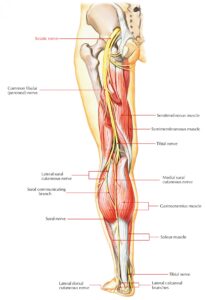Sciatica is one of the most common reasons for pain in your lower back, legs, bottom, and feet. Caused by compression of the sciatic nerve, it can make these areas feel numb, tingly, or painful.
It’s not always easy to relieve the pain from a sciatica flare-up. While physiotherapy and manual therapies are good medium- to long-term solutions, these take time to work. So how can you get rapid relief from sciatica?
Here, find out 12 ways you can get sciatica relief in eight minutes or less.
Table of Contents
What is sciatica and why is it painful?
Sciatica is an uncomfortable condition that causes pain in the lower half of your body, from your lumbar spine down to your toes. It usually affects just one side.
The sciatic nerve is the longest nerve in the human body. It runs from your lower back down to your feet.

Sciatic nerve anatomy
When the sciatic nerve is compressed (for example, by a herniated disc or a narrow spinal canal) it can cause pain that ranges from a mild ache to severe shooting sensations from your buttock down one leg. Sciatic pain can even cause referred pain in the groin area. Common symptoms of sciatica include:
- Numbness in the affected area (your legs might fall asleep more quickly than usual).
- Tingling or pins and needles from the lower back to the foot.
- Shooting pains that radiate down your leg.
- A dull ache anywhere along the sciatic region.
- Lower back pain accompanied by discomfort in the bottom, leg, hip, or feet (lower back pain on its own is rarely a sign of sciatica).
Alleviating pressure on the sciatic nerve is the best way to treat sciatica. Certain types of surgery are usually the only way to cure sciatica permanently.
But surgery isn’t an option for everyone, and in many cases you can get fast sciatica relief with more conservative treatment options. However, this is often easier said than done, especially if you’re unsure where the nerve compression has occurred and which exercises are likely to release this pressure.
12 ways to get sciatica relief in 8 minutes (or less)
Many sciatica relief techniques will provide temporary short-term relief. But you’ll need to do them many times over several weeks to see long-term results. That’s why comprehensive treatment plans that incorporate several treatment methods are often recommended by sciatica specialists.
Here are the most effective ways to relieve your sciatica symptoms quickly.
1. Rest for a short time
Sciatica can flare up if you’ve been moving a lot, walking quickly, or walking long distances. In some cases, sciatica can become so painful it’s hard to walk. So if you’ve been on-the-go all day and your sciatica symptoms are starting to show, you can get fast relief by taking the weight off your feet and resting for a few minutes [1]. If you have time to extend this to a couple of hours, you may feel greater relief.
However, bed rest won’t usually alleviate your symptoms long-term. Research shows that staying in bed too long can cause muscle weakness, which often makes sciatica worse [2]. It may also increase the risk of developing blood clots in your legs. So limit bed rest to no more than a day or two before you start to get active again.
Find out more about how to properly rest and how to sleep with sciatica plus some tips for how to relieve sciatic pain in bed.
2. Cat-cow pose
Start on all fours, with your knees positioned below your hips and your hands beneath your shoulders. With a gentle bend in the elbows, round your back while looking down towards the floor. Hold this position for a couple of seconds.
Then, smoothly and slowly, push your belly button towards the floor and arch your back downwards while looking up towards the ceiling [3].
Repeat for eight minutes or until you feel relief in your sciatic region.
3. Bridge technique
Lie on your back with your knees bent and hip-width apart. Place your hands on your stomach and keep your spine neutral.
Using your stomach muscles for stability, slowly lift your pelvis off the floor until your body forms a diagonal line from your head to your knees. Hold for a few seconds, then lower your pelvis to the ground in a controlled motion.
This exercise will strengthen your glutes while providing fast relief from sciatica [3].
4. Quadruped arm and leg lift
Start on all fours, with your knees positioned below your hips and your hands beneath your shoulders. Slowly stretch your left leg out behind you to its full extension and rest your toes on the floor, keeping your hips level.
Reach your right arm out in front of you while gently raising your outstretched leg off the floor. Try to keep your spine level, with no arching or rounding.
Hold for six seconds, then lower your leg and arm to the floor and rest for ten seconds. Repeat several times on each side for quick sciatica relief [3].
5. Piriformis stretch
If your sciatica is caused by piriformis syndrome (a condition in which the piriformis muscle below your glutes spasms and causes discomfort), a piriformis stretch may alleviate this [4].
Sit on the edge of a chair and put the foot of your affected leg on the opposite knee. Tuck your tailbone in to keep your back straight as you lean forward from the hips as far as comfortable. You should feel a stretch in your hip and lumbar region.
Maintain this for up to 30 seconds, then return to the starting position and swap sides. Repeat up to five times on each side.
Check out these NHS-recommended exercises for sciatica if you need additional examples of what to do to help relieve the symptoms of sciatica.
6. Low-impact exercise

Staying active can help improve your sciatica symptoms quickly by loosening up your sciatic nerve (providing you don’t have an activity-induced flare-up). Try one of the following to get rapid relief for sciatica:
- Go for a short walk at a slow, steady pace. (Learn more about why walking is good for sciatica)
- Do yoga to stretch out your hamstrings and strengthen your core.
- Go for a short, gentle bike ride (or use an exercise bike on a low-resistance setting).
Avoid running and other high-impact activities, at least in the short-term, as these can exacerbate your symptoms.
7. Apply an ice pack
Ice packs (or even a bag of frozen peas) can reduce inflammation and sensation around your sciatic region. Hold an ice pack to the painful area for several minutes until you start to feel relief [5].
If ice packs don’t work for you, a heat pack or hot water bottle may do the trick instead.
8. Go swimming

It’s hard to fit in a full swimming session in just eight minutes, but the good news is that just being in the water can relieve some of the pressure on your nervous system [6]. So even a short dip may help alleviate some of your sciatica symptoms.
Animal studies also suggest that swimming is an effective way to promote nerve recovery [7]. So if possible, try to make regular swimming part of your sciatica recovery exercise programme. Learn more about the benefits of swimming for sciatica.
9. Acupuncture
Some studies have shown that acupuncture can provide sciatica pain relief [8]. Acupuncture works by stimulating nerve fibres that inhibit pain signals, while also triggering endorphin release. Endorphins are the body’s natural painkillers, and may help ease your sciatica symptoms quickly and effectively.
However, you may need multiple acupuncture sessions to get lasting or long-term relief from sciatica.
10. Have a massage

Massaging the tissue in your glutes, thighs, calves, and lower back may provide quick relief from sciatica.
If possible, book a sports massage or a deep tissue massage with a professional massage therapist. If not, try one of the following self-massage techniques:
- Use a massage gun to target the affected areas.
- With a smooth-edged tool (a wooden spoon or a tennis ball can work), massage the affected area (this is similar to gua sha, which can minimise lower back pain) [9].
- Ask a friend or partner to massage the area for you.
11. Painkillers
There’s limited evidence that over-the-counter painkillers like paracetamol and ibuprofen provide fast sciatica relief [10]. But your pharmacist, GP, or sciatica specialist may be able to recommend or prescribe a different painkiller that will relieve your symptoms quickly.
These may include opioids, muscle relaxants, antidepressants, and/or anticonvulsants, though there’s still limited research into the effectiveness of each of these treatments for sciatica [11].
12. Steroid injections

Steroid injections can offer instant relief for sciatica and is something a hospital will do for sciatic pain. They’re usually administered alongside a local anaesthetic that numbs the area, providing immediate sciatica pain relief while the steroids take effect.
You may feel a little discomfort when the anaesthetic wears off, but after a few days you should start to feel much better.
At Harley Street Specialist Hospital, we offer lumbar epidural steroid injections on the same day as your assessment if you’re eligible. So you can get rapid pain relief for sciatica.
What’s the best way to treat sciatica pain?
The best way to treat sciatica pain is to unearth and address the root cause. This takes longer than eight minutes, of course, but it’s more likely to give you long-lasting results than the quick fixes out there.
At HSSH, we offer comprehensive assessment and treatment plans for all sciatica patients. With the largest pool of pain management consultants in the UK at our disposal, we’ll find out what’s causing your discomfort, whether it’s a slipped disc or an untreated back injury. From there, we’ll discuss all your options with you and formulate a unique tailored treatment plan. You can even have your first treatment on the same day.
Book an appointment with our sciatica specialists to get started.





